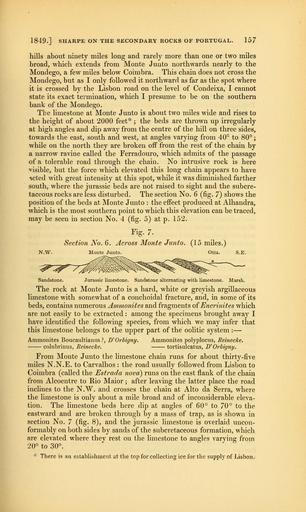MAKE A MEME
View Large Image

| View Original: | The_Quarterly_journal_of_the_Geological_Society_of_London_(13365430884).jpg (1239x2073) | |||
| Download: | Original | Medium | Small | Thumb |
| Courtesy of: | commons.wikimedia.org | More Like This | ||
| Keywords: The Quarterly journal of the Geological Society of London (13365430884).jpg 1849 SHARPE ON THE SECONDARY ROCKS OF PORTUGAL 157 <br> hills about ninety miles long and rarely more than one or two miles <br> broad which extends from Monte Junto northwards nearly to the <br> Mondego a few miles below Coimbra This chain does not cross the <br> Mondego but as I only followed it northwarrl as far as the spot where <br> it is crossed by the Lisbon road on the level of Condeixa I cannot <br> state its exact termination which I presume to be on the southern <br> bank of the Mondego <br> The limestone at Monte Junto is about two miles wide and rises to <br> the height of about 2000 feet ; the beds are thrown up irregularly <br> at high angles and dip away from the centre of the hill on three sides <br> towards the east south and west at angles varying from 40 to 80┬░ ; <br> while on the north they are broken oif from the rest of the chain by <br> a narrow ravine called the Ferradouro which admits of the passage <br> of a tolerable road through the chain No intrusive rock is here <br> visible but the force which elevated this long chain appears to have <br> acted with great intensity at this spot while it was diminished farther <br> south where the Jurassic beds are not raised to sight and the subcre- <br> taceous rocks are less disturbed The section No 6 fig 7 shows the <br> position of the beds at Monte Junto the effect produced at Alhandra <br> which is the most southern point to which this elevation can be traced <br> may be seen in section No 4 fig 5 at p 152 <br> Fig 7 <br> Section No 6 Across Monte Junto 15 miles <br> N W Monte Junto Otta S E <br> Sandstone Jurassic limestone Sandstone alternating with limestone Marsh <br> The rock at Monte Junto is a hard white or greyish argillaceous <br> limestone with somewhat of a conchoidal fracture and in some of its <br> beds contains numerous A nmonites and fragments of Enc 'inites which <br> are not easily to be extracted among the specimens brought away I <br> have identified the following species from which we may infer that <br> this limestone belongs to the upper part of the oolitic system ö <br> Ammonites Boucaultiamis ' D'Oriigny Ammonites polyplocus Reinecke <br> colubrinus Reinecke tortisuleatus B Orhigny <br> From Monte Junto the limestone chain runs for about thirty-five <br> miles N N E to Carvalhos the road usually followed from Lisbon to <br> Coimbra called the Estrada nova runs on the east flank of the chain <br> from Alcoentre to Rio Maior ; after leaving the latter place the road <br> inclines to the N W and crosses the chain at Alto da Serra where <br> the limestone is only about a mile broad and of inconsiderable eleva- <br> tion The limestone beds here dip at angles of 60┬░ to 70┬░ to the <br> eastward and are broken through by a mass of trap as is shown in <br> section No 7 fig 8 and the Jurassic limestone is overlaid uncon- <br> formably on both sides by sands of the subcretaceous formation which <br> are elevated where they rest on the limestone to angles varying from <br> 20┬░ to 30┬░ <br> There is an establishment at the top for collecting ice for the supply of Lisbon 36933982 113689 51125 Page 157 Text v 6 http //www biodiversitylibrary org/page/36933982 1850 Geological Society of London NameFound AmMONITES polyplocus NameFound Boucaultiamis NameFound Estrada nova NameFound Maior NameConfirmed Maior NameBankID 5332597 Biodiversity Heritage Library The Quarterly journal of the Geological Society of London v 6 1850 Geology Periodicals Smithsonian Libraries bhl page 36933982 dc identifier http //biodiversitylibrary org/page/36933982 smithsonian libraries Information field Flickr posted date ISOdate 2014-03-23 Check categories 2015 August 26 CC-BY-2 0 BioDivLibrary https //flickr com/photos/61021753 N02/13365430884 2015-08-26 12 01 27 cc-by-2 0 PD-old-70-1923 The Quarterly journal of the Geological Society of London 1850 Photos uploaded from Flickr by F├” using a script | ||||